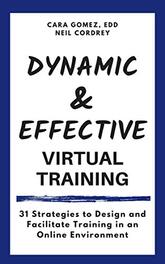| Two books to help with virtual and classroom meetings along with business meetings. Dynamic and Effective Virtual Training helps trainers and leaders create online training that is effective and keeps the attention of the participants. Learn more by obtaining a paper or electronic version of Dynamic and Effective Virtual Training on Amazon Link to Dynamic and Effective Virtual Training |
Two Minute-Facilitator
We evaluated many training sessions and identified the key reasons the training was effective and well received by the participants. We captured these approaches in a resource called The Two - Minute Facilitator. Use the link to purchase a copy from Amazon.
We evaluated many training sessions and identified the key reasons the training was effective and well received by the participants. We captured these approaches in a resource called The Two - Minute Facilitator. Use the link to purchase a copy from Amazon.


 RSS Feed
RSS Feed